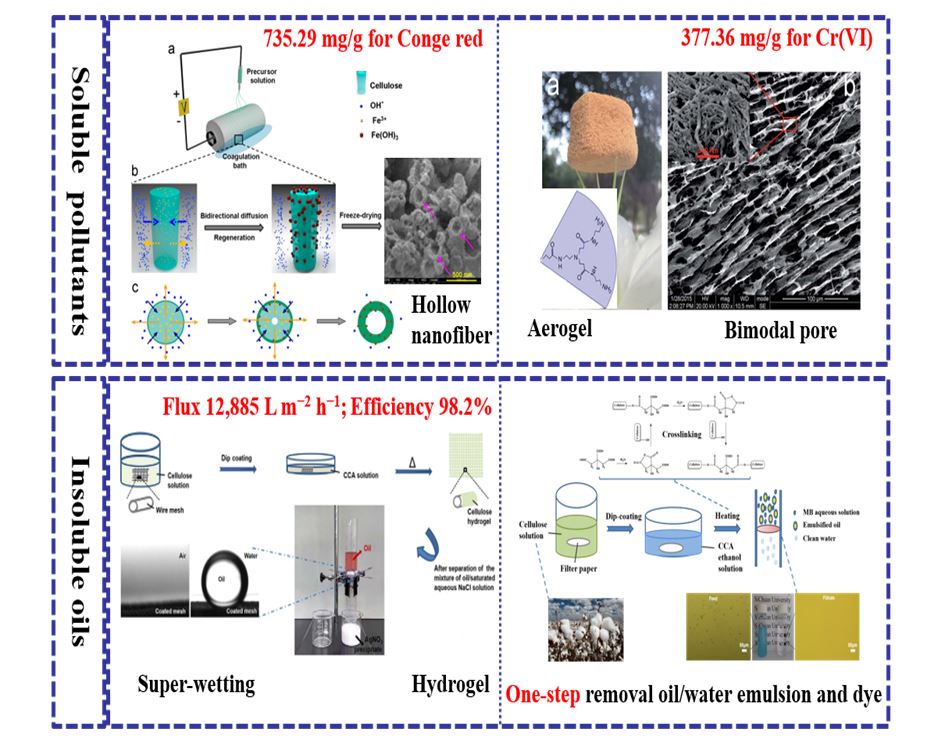Video Article Open Access
Nanocellulose Materials in Water Treatment
Wei Zhang1,2,*, Jiangqi Zhao1, Chenghong Ao1, Canhui Lu1,2
1State Key Laboratory of Polymer Materials Engineering, Polymer Research Institute at Sichuan University, Chengdu 610065, China
2Advanced Polymer Materials Research Center of Sichuan University, Shishi 362700, China
Vid. Proc. Adv. Mater., Volume 2, Article ID 2021-0185 (2021)
DOI: 10.5185/vpoam.2021.0185
Publication Date (Web): 13 Feb 2021
Copyright © IAAM
Graphical Abstract

Abstract
Wastewater discharged from expanded manufacturing, processing of chemicals, electronic materials and petroleum, contains a huge amount of pollutants like toxic heavy metals, oils and organic dyes. There is an urgent need to develop new strategies and techniques for water purification. Sustainable and environmentally benign nanocellulose materials are much attractive from the surface properties and economic viewpoints as adsorbents for different pollutants. Herein, we report a series of novel materials derived from nanocellulose for water treatment with an emphasize on the structural design that governs their performance. The chemical composition, micromorphology, special wettability, porosity, etc., can be well defined to target various water-soluble pollutants. For example, a dendrimer poly(amidoamine)-grafted cellulose nanofibril (PAMAM-g-CNF) aerogel is synthesized, which bares abundant functional groups with a bimodal pore structure and a high specific surface area, leading to a record-high Cr(VI) removal capacity of 377.36 mg/g. Another example is the membrane filter that is comprised of unique hollow nanofibers from electrospun cellulose. It demonstrates distinct advantages of high flexibility and high-water flux, and can be assembled into flat membrane modules and spiral-wound membrane modules for high efficiency treatment of industrial/agricultural wastewater and drinking water which contains a trace amount of toxic pollutants. This work indicates that nanocellulose is rather appealing for future wastewater remediation. With regard to insoluble oils, inspired by the fish scale, a cellulose hydrogel-coated mesh was prepared by a simple dip-coating and heating process. Owing to the abundant hydroxyl groups and microscopic roughness of the cellulose hydrogel, the resulting mesh exhibited superhydrophilicity and underwater superoleophobicity, leading to high flux, high oil/water separation efficiency and excellent recyclability. Meanwhile, insoluble oils often coexist with soluble dyes. An all-cellulose composite membrane was fabricated using a filter paper as the substrate, a cellulose gel as the coating layer and an edible citric acid as the crosslinker and active compound, which could separate oil-in-water emulsion and remove dye from water simultaneously.
Keywords
Cellulose aerogel, cellulose nanofiber, electrospinning, water treatment.
Acknowledgement
This work was supported by the National Natural Science Foundation of China (51861165203), the Sichuan Science and Technology Program (2019YJ0125), the State Key Laboratory of Polymer Materials Engineering (sklpme2019-2-19), the Opening Project of Guangxi Key Laboratory of Calcium Carbonate Resources Comprehensive Utilization (HZXYKFKT201902) and the Fundamental Research Funds for the Central Universities.
References
- J. Zhao, Z. Lu, X. He, X. Zhang, Q. Li, T. Xia, W. Zhang, C. Lu, ACS Appl Mater Interfaces, 2017, 25339.
- J. Zhao, X. Zhang, X. He, M. Xiao, W. Zhang, C. Lu, J. Mater. Chem. A, 2015, 3(28), 14703-14711.
- C. Ao, R. Hu, J. Zhao, W. Zhang, C. Lu, Chem. Eng. J., 2018, 338, 271-277.
- C. Ao, J. Zhao, W. Zhang, C. Lu, Carbohy. Polym., 2020, DOI: 10.1016/j.carbpol.2020.116872.
Biography
Wei Zhang received his BEng (2005) and MEng (2008) and PhD (2012) degrees from Sichuan University, China. During 2009-2011, he studied in Georgia Institute of Technology as a visiting student. Right after graduation, he joined Sichuan University as Assistant Professor. He was promoted to Associate Professor in 2014. His research is mainly focused on biopolymers, particularly nanomaterials from renewable resources, such as cellulose nanofibers, chitin whiskers, etc. The fabrication of cellulose nanofibers and their interdisciplinary applications in green nanocomposites, energy storage, water treatment and tissue engineering have been the active topics in his research group. So far, he has published 70+ peer reviewed paper in prestigious journals, which have received 2200+ citations excluding self-citations with an H-index of 29 according to the Web of Science Core Collection. And his research work has been highlighted by many scientific news media, namely, C&EN, VeriticalNews, PharmacyChoice, Global Medical Discovery, etc. He is an editor/editorial broad member for 8 international journals, and has served as the referee for 60+ SCI journals including many highly reputed ones, such as Advanced Materials, ACS Nano, and so on.
Video Proceedings of Advanced Materials

Upcoming Congress



